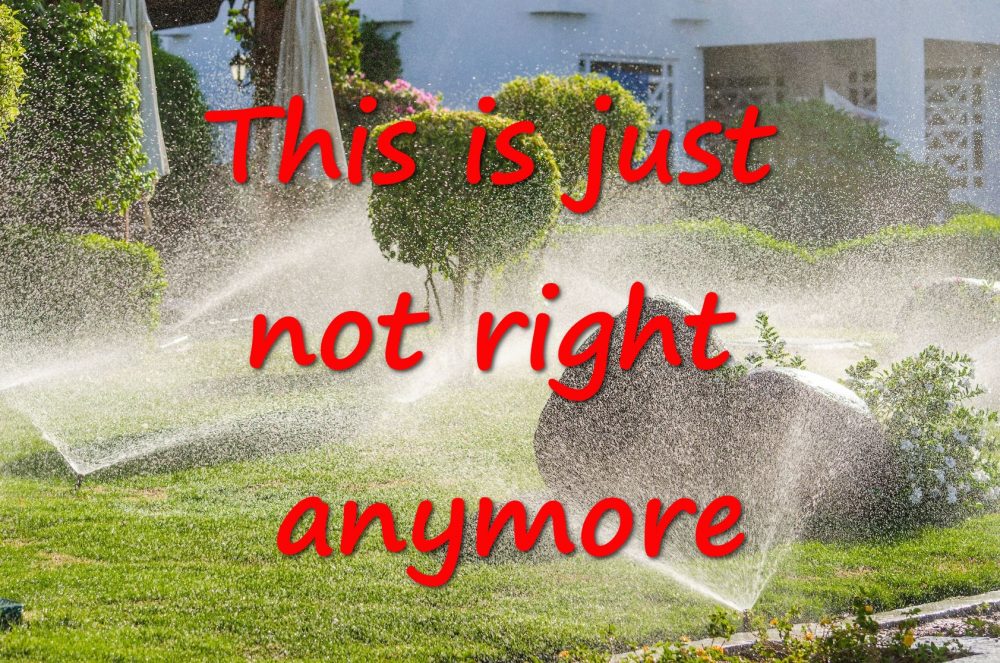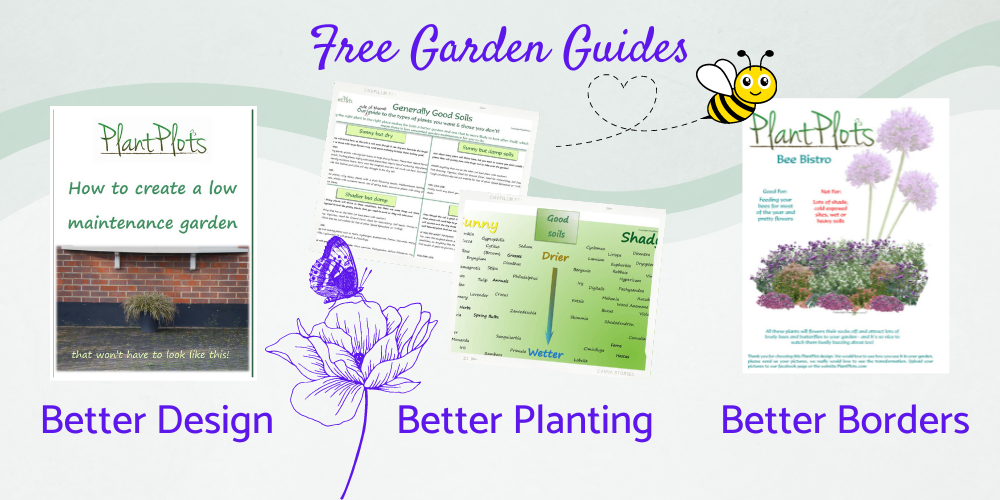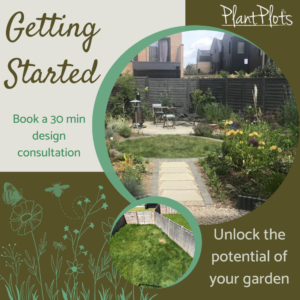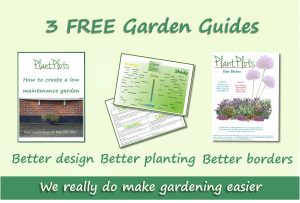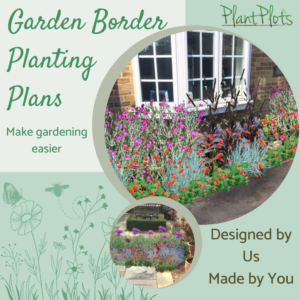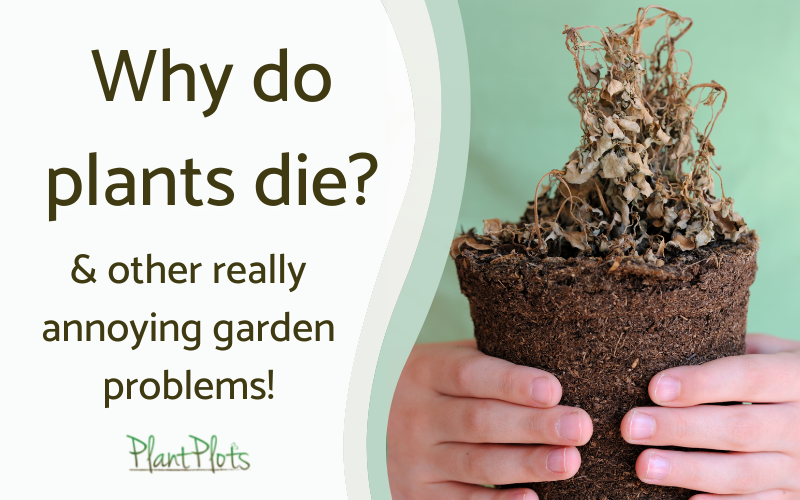
Why do plants die after planting?
Gardening can be so annoying! You spend loads of money on planting the garden and then after a few weeks, the plants start dying! In addition to some plants dying, other plants just fail to thrive, look sick, weak or flop on the ground.
Here are some reasons why this happens along with tips and advice so your garden looks healthy, vibrant and full of life.
Use the buttons below to skip to the right section
Why do Plants Die?
Finding out the reason why plants die after planting outside can be a little tricky, as there are several possible causes:
- The plant was sick when you planted it.
- You’ve planted it in totally the wrong area for it to thrive.
- Soil; plants can be quite particular.
- You’ve forgotten to water it!
- It’s drowned from too much watering.
- Waterlogged soil kills most non-aquatic plants.
- The ground is so dry the plant just dies.
- Roots were left exposed when it was planted.
- It is diseased or is being eaten.
- The weather (frost and cold) has killed it
- Too much sun has caused it to shrivel and die
Plants evolved to grow in lots of different environments.
The key to having ‘happy plants’ then involves asking two questions:
- How does this plant like to grow and
- What is in my garden will prevent that from happening!
If the plant has an uphill struggle just trying to survive, you cannot expect it to produce the display you want it too. The environment in your garden ideally should match how the plants want to grow. That way the plant will grow as it wants to and produce the display it is capable of.
The plant will look after itself, which means you don’t have to!
Right Plant, Right Place:
Flowers don’t easily grow in a desert, but some will. So you need to know what your garden ‘does’ and then find plants that like the same thing as your garden likes doing.
If you don’t then there are 3 possible outcomes:
- You have to spend ages looking after your plants.
- Your plants will hate it, sulk or get sick.
- Or your garden is too good for them, they all grow like rampant triffids taking over everything and generally look a mess.
To find out more about planting and getting the right plants for your garden, why not buy our amazing book. Available at Amazon and other online bookstores.
Why do Plants Flop Over?
I know, past 40 we all begin to suffer from a little ‘ flop and droop’ but you don’t want the garden to follow suit! So why do your plants flop and never seem to grow strongly?
Well it’s all down to 3 things – LIGHT LEVELS, SOIL and BREEDING
Light levels:
OK, a bit basic, but plants grow toward the sunlight.
If light levels are low, the plant tries to grow really fast to get to as much light as possible quickly, it becomes a leggy skinny teenager of a plant.
Once it has reached the light, it isn’t strong enough to support itself properly, so the plant will flop over – just like a leggy skinny teenager!
If light levels are low then look to raise the branches of overhanging trees and shrubs to allow more sunlight down onto the soil. You can also thin out the branches to let more light through.
The plants will grow stronger from the bottom up. So they won’t flop over as easily.

What’s the soil like:
Your plants will grow really well if they have food and water, so the soil really determines how well everything will grow.
A poor soil that lacks nutrition will produce weak straggly plants that flop easily or droop everywhere.
The slightest puff of wind will send you ‘prize specimens’ heading for the floor!
But the soil can be too rich as well…
This is because of the way plants ‘think’ and they’re a bit like us in this respect.
If we constantly eat too much, we become fat, less fit and a little more lethargic. Its the same with plants.
The plant becomes ‘fat and lazy’ which in plant terms means it produces lots of sappy green growth which is wobbly and floppy.
If the plant is in a less rich soil, it starts behaving as though it will probably die.
This causes it to think, ‘ooh must reproduce myself quickly before I conk out’. So it starts to flower copiously in order for it to produce seeds, so there is less energy to devote to growing all those succulent green leaves.
So an over rich soil for plants that don’t need much food produces floppy plants too.

If plants roots cannot penetrate the soil or, they can’t absorb the nutrients, so they starve… & flop over.

This soil is too rich for the grasses. They are in essence overweight!
Breeding:
This Dahlia is impressive, but it is not a naturally occurring flower shape.
Horticulturalists and plant breeders use all sorts of techniques to create new subspecies of plants. Colours are enhanced, and the size, shape and volume of petals flowers produced by the plant have been selectively bred to create bigger bolder and brighter blooms.
But this comes at a price – added weight.
If raindrops collect in the petals of this Dahlia, it will simply flop over. The flowerhead becomes too heavy for the plant stem to hold it upright.
You are told to use stakes and plant supports to keep the plants upright. Couple that with possible poos soil and inadequate light levels and your plants will struggle.
As soon as the wind blows or the rain falls; your prize specimens will flop to the floor.
Our advice, keep flowers simple and natural, and avoid over-cultivated hybridised flowers.
It’s much easier and the garden is just as beautiful!
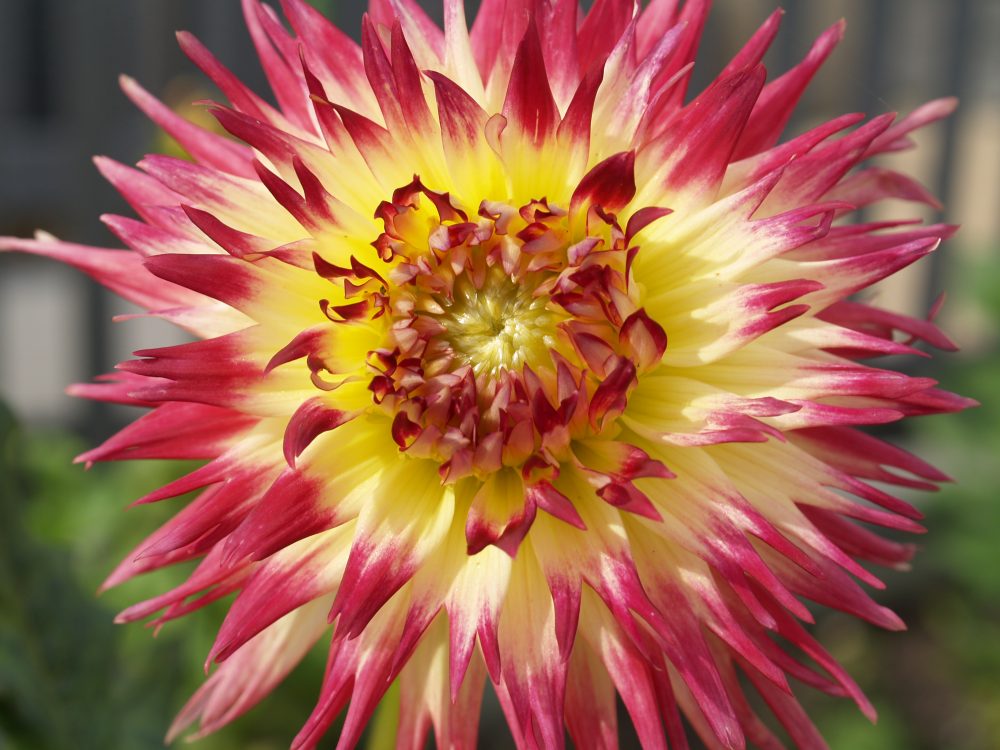
If you like Dahlias that’s fine, but they are not low-maintenance plants to look after. and neither are Roses!

Dealing with a Weed-filled Garden
Gardens are unfortunately a little like toddlers, under a watchful eye they behave and can be utterly delightful. Left to their own devices though, in no time at all chaos ensues! Before you start to change any garden, deal with what will cause you a problem in the future. A weed-filled garden now will also become a weed-filled new garden too.
Firstly, Don’t Despair:
The garden can be tamed, but it will take time and effort – there are no quick fixes. Firstly and most importantly, make sure things don’t get any worse.
Don’t let any unwanted plants set seed!
Cut down and dispose of any seedheads before they ripen. When strimming, trimming, cutting or mowing, don’t add the clippings to any compost heap, these will be full of seeds. Dispose of all the garden waste at the local tip or if allowed, have a small bonfire.
Secondly, tackle any ‘triffids’; any overgrown straggly thickets of climbers or shrubs. If it can’t be restored, get rid of it entirely. Cut the plant back to a manageable size; a really manageable size. There’s no point in having the flowers of a shrub 10 feet up, all you will see are the bare stems. Reduce the height of the plant to no more than 6 feet to start with.
Now many horticulturalists will throw their hands up in horror at this advice, but the aim is to identify the plants worth keeping and those that aren’t.
All the plants in a small garden have to look good from top to bottom, there is not enough space to hide ugly shrubs with nicer-looking plants. Being ruthless will allow you to decide which plants can stay and which must go.
Create a Holding Plot:
Overgrown gardens can be quite daunting, so tackle them bit by bit. There will be plants worth keeping amongst all the weeds and triffids. It is a good idea to create a place to put these whilst tackling everything else.
Clear a space in the garden, dig it over and carefully remove any roots in the soil. If the plant is worth keeping, dig it up and temporarily replant it.
Do check the rootball for other roots and remove them or wash the soil off completely before replanting to minimise any weed regrowth.
Make one part ‘nice’:
Taming and replanting any overgrown weed-filled garden will be a long-term project. So, create a small space temporarily where you would like to sit and make that a welcoming place.
Use pots filled with saved plants dug from the garden. New plant purchases can be potted up and placed around the sitting area too, these can then be planted in the ground when all the clearing is done.
Use a windbreak screen or a trellis to ‘hide the worst bits’ but just create a small oasis for a cup of tea and a sit-down…that you can enjoy until you get the rest done.
Don’t cheat when weeding!
A weed-filled garden will grow in a variety of ways, but it has one common characteristic and that is weeds grow faster than anything else!
There are the Annual Weeds – these go from seed to fully-fledged seed-producing machine faster than Usain Bolt! To get rid of them, pull up the plant and cut off the seed heads before they ripen.
Then there are the Perennial Weeds – these regrow from the roots. Now some have roots that burrow to the centre of the earth. Some have roots like a plateful of spaghetti – unfortunately, both will regrow from the tiniest piece of root left in the soil.
So removing only the plant above ground is utterly pointless. The plant thinks ‘oops, lost my green top – better send up lots more!’
Using a Rotavator- will make this problem 1000 times worse as each tiny fragment of chopped-up root will also think “hey – got no green top, better regrow one, fast!”
Lastly, there are the weeds you never knew you had….these are the millions upon millions of seeds that are sitting on top of the ground waiting for you to dig over the ground and inadvertently plant them!
Be Patient and Thorough:
Clearing overgrown gardens are hard work but the more thoroughly it is cleared at the outset the easier the garden will be to maintain in the long term – it really is a stitch in time saves nine!
- Dig the ground and remove any roots.
- Dispose of the waste at the local tip, not in the compost bin.
- Dig out bulbs and anything else that looks like it may grow, pop these in a pot if you are not sure if it’s a friend or foe, let it grow and see if it’s worth keeping.
- Do not plant anything in the cleared ground for several weeks to let the ‘new’ weeds sprout and get rid of these.
- It is best to tackle the garden clearance in Spring or Autumn then the ground is not baked dry or utterly waterlogged.
Now it may be tempting to reach for the weedkiller to speed things up, however, all weedkillers are pretty noxious chemicals. They may be necessary for some difficult weeds, but try to use them sparingly and only if there is no real alternative.
Why your Indoor Plants Die
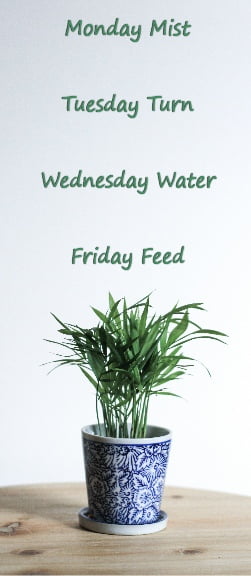
Indoor plants are really fashionable at the moment and they look wonderful displayed in the garden centre and when we thumb through the photos in interior magazines. Plants enhance the decor of our living spaces and they benefit our health physically and mentally.
So as fashions go – indoor plants are a good one to buy into, so why on earth when you get these plants home do they end up looking so naff/ill or they just end up dying?
More importantly though what can you do to keep them looking happy?
Before you buy any indoor plant though, remember,
All plants evolved to grow outside and not inside, so by sticking them indoors you are already fighting nature.
The key to indoor plant success, therefore, is to keep those negative factors to a minimum for that particular plant.
OK, so let’s take each of these problems in turn and find a solution.
- Lack of light
- Lack of water
- Too much water (if you stood in a cold puddle for days you’d be cheesed off too!)
- Dry Air, either from central heating or air conditioning
- Freezing to death on a cold windowsill behind the curtain
- The wrong type of water – yep; some plants don’t like tap water!
There’s more explanation below, but here’s a rule of thumb guide to: ‘What can you tell from a leaf’

Lack of Light:
All plants seek out sunshine and will grow towards the light. Some plants have evolved to cope with lower light levels and some plants need a lot of sunshine to thrive. So the trick is getting the right plant for the right light levels.
Now you may think a sunny windowsill is perfectly good, but for a plant, it’s not, it’s only getting light on one side all day long, so it will turn its leaves and flowers to face the light – and you get a lop-sided specimen.
So a quick, free and easy solution is to turn the plant a 1/4 turn each day – which mimics the action of the sun moving around the sky.
Windows that aren’t sunny – there are plenty of plants that will happily grow here, you just need to place a plant that would normally grow in lower light levels. Still turn them if possible, but not so frequently.
Lack of Water:
We all do it, and we all forget to water, now if this is you; then buying plants that will quickly shrivel up at the first thirsty moment are not ones you should buy…..Maidenhair Ferns…. no matter how lovely they look in the garden centre!
But there are lots of plants that will absolutely thrive on not a lot of water.
It’s all about Right Plant: Right Place, or in this case Right Human: Right Plant!
If you are prone to forgetting to water, then best invest in a watering device, like a reservoir in a small bulb that you stick in the soil.
AND
Don’t put plants in the hottest sunniest spots in you house unless they are cactus!
Too Much Water:
The only plants that like standing in water are those that normally grow in a pond!
Familiar scene? …..
‘Oops, forgot to water so will throw a bucket over it which fills up the tray, but that’s ok the plant can suck up over the next few days…’
OR
‘We are going on holiday, better fill the tray with lots of water before we go…’
You stand in a bucket of cold dirty water for a few days and see how you feel – it’s the same for your plants!
If the tray is filled up after watering, tip out the excess water.
If you are going away – do as the above, use a water reservoir to slowly water the plant AND move the plant to a less hot and sunny place, so it doesn’t get so thirsty.
Dry Air:
Question – do you use moisturizer?
Probably the answer is yes; Sunshine, Cold Air or Dry air makes most skin feel leathery and wrinkly.
Plants get ‘wrinkles’ too!
So a simple solution is to spray or mist the leaves.
Do this in the summer but more importantly in the Winter when the central heating is on.
Freezing Places:
When you draw the curtains in the winter, the curtains stop the heat from the room from escaping to the window and they stop any cold draughts from the window from cooling the room.
So the poor old plant that sits on the windowsill gets its brass monkeys frozen every night!
Now that is fine for plants that love big temperature differentials, similar to those you get in a desert..hot days; cold nights, but most other plants hate it!
The Wrong Type of Water:
Most countries add ‘stuff’ to our drinking water to keep it clean and pure and our teeth healthy. Now many plants don’t give a flying hoot as to what type of water it is, but some do and will get really cheesed off if you don’t provide them with rainwater.
Plants that really hate tap water:
Orchids: most, if not all of them
Citrus: so, Oranges, Kumquat, Lemons etc
AirPlants: those funny-looking things that don’t need a pot to grow in
Cactus: why would you want chemical-flavoured water if you evolved to only get a drink once in a blue moon…!
Lastly, Food and bugs:
Having concentrated on the 5 main plant killers, there are two further potential problems.
Food: too much or too little and
Bugs and other nasties.
Correct feeding is so much easier these days. Use the slow-release fertilisers so you don’t have to remember to feed every week AND never give an extra dollop for plant food because the plant is looking peaky. Find out why it’s looking peaky, but don’t overfeed.
Being indoors is no protection from insects determined to eat your prize specimen, so you need to check for invaders if the plant is looking poorly.
There are no Garden Pests - just Bad Biodiversity
To explain, first we have to take a step out of your garden.
Humans are part of the great ecosystem of this planet, we don’t run the ecosystem of this planet.
Secondly, and apologies for the cliche, but there is a circle of life as well, so if we cut out one part, life can’t circulate. Pesticides weedkillers and insecticides all damage the cycle, so, the best remedy? – natural pest control.
Plants get eaten by bugs, bugs get eaten by predators, predators get eaten by bigger predators etc and so on. So if bugs have a prolific breeding splurge – more predators are attracted to eat said bugs thus bringing it all back into balance. So we do need some bugs in the garden.
Good Garden Bugs
Gardens are part of the natural world, albeit created by us, but nevertheless, your garden can be an extremely biologically diverse place. All environments however small though, are ecological systems, with a hierarchy of ‘eat and be eaten’ animals. However, there are some creatures we would all class as good garden bugs.
All small garden birds, bats, damselfly dragonflies, hedgehogs, frogs, toads, lizards, ground beetles, stag beetles, bees, lacewings, hoverflies, butterflies, moths, frogs, toads, earthworms and centipedes.
Make sure you have a small compost bin (if possible), spray insecticides minimally, buy more ‘open’ flowers (so insects can get into the nectar) and try to ensure that something is in flower all through the year.
It is not difficult to attract wildlife into your garden, but it is so much more rewarding if you do – and there will over time be fewer nasties eating your prize blooms!
Ensure your garden has a good ecosystem – plant lots of varieties of insect-friendly flowers throughout the year. Visit the shop to see all the predesigned planting ideas packed full of bee-friendly flowers.
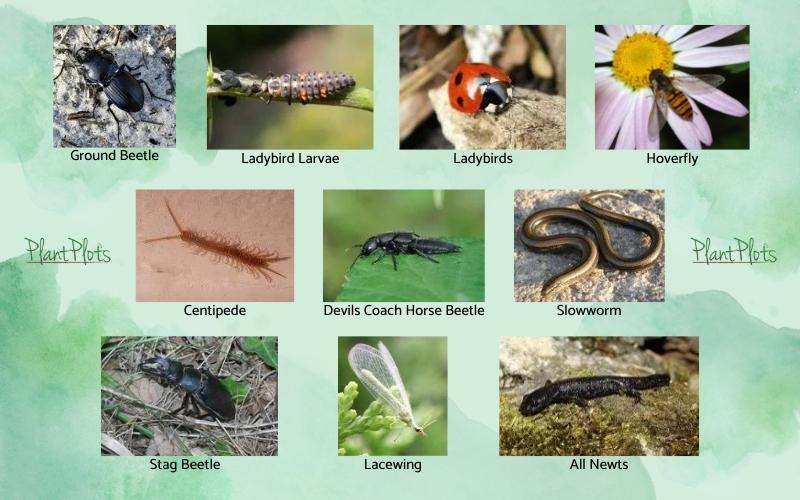
But, you cry – the bugs are still eating my plants! Well yes, although you will never prevent that from happening entirely – but spraying will only prolong the problem.
Insecticides work by killing all insects
Insecticides sprayed onto flowers can last on there for weeks, so will kill any insect that feeds off the plant or drinks the insecticide-soaked nectar! The result is that although you kill the ‘pests’ you also kill the first rung of pest predators as well as killing all the useful insects too.
So you need to accept some ‘bad bugs’ in your garden, as they are the bottom rung of the food chain. These will attract predators which in turn attract predators higher up the chain. Everything starts eating everything and over a period of time Nature balances out the volume of pests with the predators.
If you get infested with plant-eating pests, it is most likely because you have been too zealous with spraying and thus you get trapped in a vicious circle of more and more spraying to deal with the problem.
You need to break this cycle and adopt a more balanced long-term strategy.
Start by accepting you are not going to have a show garden with picture-perfect plants and not a munch hole in sight.
Take a look at the plants you have
Are there any flowers or plants that are attracting insects (other than aphids). If not, then your garden is not a balanced ecosystem. You need to plant more insect-friendly flowers.
Are there any plants that have been decimated by a bug attack –
Decide do you really love this plant enough to keep it in the garden and defend it every year.
Can you see hoverflies, ladybirds or lacewings?
These are the next level up the food chain and either they or their larvae love aphids. So if you haven’t any, then you can attract them easily by planting more insect-friendly flowers to attract them in.
Birds, Bats, Frogs, Beetles and Hedgehogs
All these are much more efficient bug hunters than you could ever be, so do not use slug pellets everywhere – you just kill larger predators who eat the poisoned slugs. Put up bird boxes, have a hole in the fence for a hedgehog, and leave a little leaf debris in the flower borders for beetles to hide away in. And if you have bird feeders – put them high enough so cats can’t jump up and get the birds!
How many plants flower in your garden in the winter?
– Bees forage for food on sunny winter days, so help them with a few insect-friendly flowering plants.
Don’t spray Flowers
If you do feel the urge to spray then you can minimise the damage with a little more thought. Insecticide lasts on the plants for some time, so if you spray into the flowers, you will kill any bee or butterfly that lands there, so if you really really have to spray, spray before the flowers have opened. Spray on a windless day and best for insects if you spray after they have tucked themselves up for the night, but moths come out to feed on flowers too, so either way.
Use a Soft Soap Spray
Liquid detergent especially the plant-based eco ones are quite handy. The detergent spray ‘gums’ up the aphids, so they can’t breathe or move and then they die.
Employ other defensive tactics!
There are loads of non-insecticidal methods to tackling bugs without destroying all life in the garden. In the case of the fish, maybe not in a small suburban garden!
- Garlic & Chilli Spray – Use 2-3 whole garlic, 12 hot chilli’s (or a tsp of powder), 1 tbsp vegetable oil, and 3 squirts of washing up liquid (an eco one is best). Blitz in a processor and add approx 3 pints of water. Pop in a sprayer and spray on your plants. The theory is the bugs don’t like the taste so don’t eat your prize blooms!
- Fish Spray – not for the faint-hearted this. Some leftover fish in a bucket and left to brew for a couple of weeks (at the end of the garden..!) strain and then spray the ‘essence’ over your plants. Apparently, bugs don’t like a rancid fish taste either – but then who does?
- Shiny Things – adding bits of tin foil or other shiny surfaces near your plants can help repel bugs. The light reflecting off them confuses bugs into missing your flowers apparently.
- Sticky Traps – These stick any insects to their surface, they are best used in greenhouses. They aren’t the most attractive things to have dangling around
- Molasses – 1 tbsp in some hot water along with some washing up liquid and sprayed onto plants. Again the sticky molasses coats the aphids and suffocates them.
OK well molasses and fish spray may be a bit OTT… but there are these too.
- Vinegar Spray – Use 1 tbsp per litre. Don’t spray on a sunny day or the vinegar will burn the leaves.
- Boiled leaves – Boiled tomato or Rhubarb leaves left to infuse a couple of hours, strained and popped in a sprayer are supposed to be a proper ‘insecticide’
- Physical Barriers – Use netting and cloches to provide impenetrable barriers to bugs. Remember though, if the bugs do get in, the barriers provide protection from bug predators as well.
- Sacrificial Plants – Plant a fab food for bugs that is irresistible (Nasturtiums…) amongst your more favoured specimens.
- Companion Plants – These are plants that either attract lots of beneficial insects like hoverflies and ladybirds. Or they help disguise the scent of your favourite plant by emitting their own scent – chives do both for example.
- Get a Duck – OK you won’t have any slugs……but maybe a bit radical for the average suburban garden?
- Love a Hedgehog – These are some of our best bug hunters. More cute and less messy then ducks. Have a little hedgehog ‘hotel’ and don’t use slug pellets!
We hope you are more convinced of the benefits of biodiversity. It will take time though for the natural balance to be restored.
Keep the faith, Nature always gets it right if we let Her.
All the above pest control remedies are provided for information purposes only.
